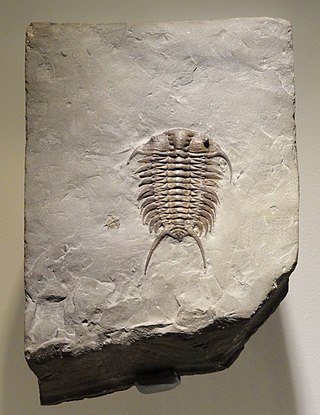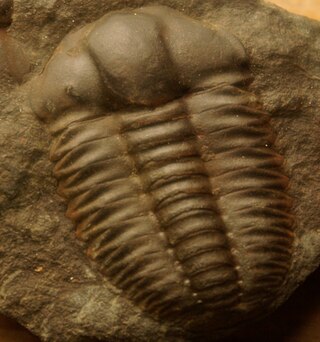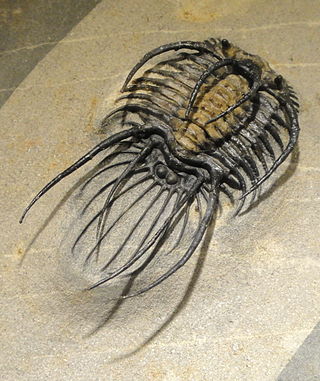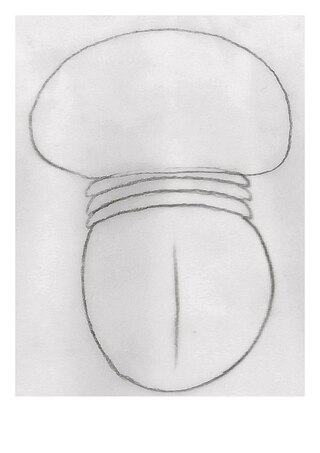Related Research Articles

Terataspis is a comparatively huge, 60 centimetre long lichid trilobite genus from the Early Devonian, about 397 million years ago. It lived in a shallow sea in what is now New York State and Ontario. No whole specimens have been found, only disarticulated fragments of its exoskeleton, but enough fragments have been found to allow researchers to form reconstructions of the whole animal. The genus only contains one species, T. grandis.

Ceraurus is a genus of cheirurid trilobite of the middle and, much more rarely, the upper Ordovician. They are commonly found in strata of the lower Great Lakes region. These trilobites have eleven thoracic segments, a very small pygidium and long genal and pygidial spines.

Walliserops is a genus of spinose phacopid trilobite, of the family Acastidae, found in Lower to Middle Devonian age rocks from the Anti-Atlas Mountains of Morocco. All species of Walliserops possess a three-pronged "trident" that protrudes from the glabella. Walliserops is most closely related to the genus Comura.

The bee subfamily Andreninae is a nearly cosmopolitan lineage, with most of its diversity in one genus, Andrena, which contains over 1500 species. The remaining four genera in the subfamily only contain a total of 9 species.
Parapagetia is an extinct genus from a well-known class of fossil marine arthropods, the trilobites. It lived during the Botomian stage, which lasted from approximately 524 to 518.5 million years ago. This faunal stage was part of the Cambrian Period.

Encrinurus is a long-lived genus of phacopid trilobites that lived in what are now Africa, Asia, Australia, Europe, North America, and South America from the middle Ordovician to the early Devonian from 472 to 412.3 mya, existing for approximately 59.7 million years.

Helmetia is an extinct genus of arthropod from the middle Cambrian. Its fossils have been found in the Burgess Shale of Canada and the Jince Formation of the Czech Republic.

Cheirurus is a genus of phacopid trilobites that lived from the Ordovician to the Devonian. Its remains have been found in Africa, Asia, Australia, Europe, and North America. Cheirurus is the type genus of Cheiruridae.
Arduennella is a Devonian homalonotid genus of trilobite in the order Phacopida, which existed in what is now Belgium, Germany, Morocco and Romania. It was described by Wenndorf in 1990, and the type species is Arduennella maillieuxi, which was originally described as Homalonotus maillieuxi by Asselberghs in 1923.
Burmeisterella is a genus of trilobites in the order Phacopida. It was described by Reed in 1918.
The Dresbachian is a Maentwrogian regional stage of North America, lasting from 501 to 497 million years ago. It is part of the Upper Cambrian and is defined by four trilobite zones. It overlaps with the ICS-stages Guzhangian, Paibian and the lowest Jiangshanian.

Ellipsocephalus Zenker, 1833, is a genus of blind Cambrian trilobite, comprising benthic species inhabiting deep, poorly lit or aphotic habitats. E. hoffi is a common trilobite mainly from central Europe.

Odontopleuridae is a family of odontopleurid trilobites found in marine strata throughout the world. Odontopleurids of Odontopleuridae first appear in Late Cambrian-aged marine strata, and the last genera perish by the end of the Frasnian stage during the Late Devonian. The members of Odontopleuridae are famous for their spinose appearance, having long, often numerous spines along the edges of their exoskeletons, and derived from ends of segments or tubercle ornaments.

Illaenus is a genus of trilobites from Russia and Morocco, from the middle Ordovician.

Soomaspis is a genus of small to average size marine arthropods in the Liwiidae Family, that lived during the late Ordovician. Fossil remains of Soomaspis were collected from the Soom Shale Lagerstätte in Western Cape, South Africa. Soomaspis looks like a large, soft agnostid trilobite. It has a headshield wider than the tailshield (pygidium), and in between them three thoracic body segments (somites). The genus is monotypic, its sole species being Soomaspis splendida.

Trinodus is a very small to small blind trilobite, a well known group of extinct marine arthropods, which lived during the Ordovician, in what are now the Yukon Territories, Virginia, Italy, Czech Republic, Poland, Denmark, Sweden, Svalbard, Ireland, Scotland, Wales, Iran, Kazakhstan and China. It is one of the last of the Agnostida order to survive.

Proetus is a genus of proetid trilobite found in Silurian-aged marine strata of Europe.
TrilobitesLink, 1807 is a disused genus of trilobites, the species of which are now all assigned to other genera.
Aponileus is an extinct genus of trilobites. Chung-Hung Hu circumscribed the genus in 1963. The genus was once considered a junior subjective synonym of the genus Psephosthenaspis but it is considered to be a distinct genus again. As of 2021, fossils have been found in Greenland, Texas, and Utah. They all date to the Upper Floian (Blackhillsian) within the Ordovician Period.

Pseudophillipsia is a genus of trilobite, notable for being one of the last members of the group before the extinction at the end of the Permian. It first appeared during the Pennsylvanian or Late Carboniferous. There are several species and this genus has a range spanning Eurasia.